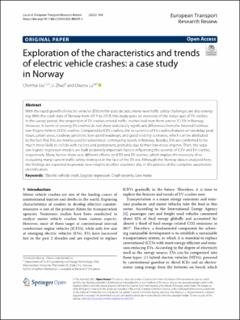| dc.contributor.author | Liu, Chenhui | |
| dc.contributor.author | Zhao, Li | |
| dc.contributor.author | Lu, Chaoru | |
| dc.coverage.spatial | Norway | en_US |
| dc.date.accessioned | 2022-05-30T13:23:35Z | |
| dc.date.available | 2022-05-30T13:23:35Z | |
| dc.date.created | 2022-03-24T09:32:06Z | |
| dc.date.issued | 2022-03-14 | |
| dc.identifier.issn | 1867-0717 | |
| dc.identifier.issn | 1866-8887 | |
| dc.identifier.uri | https://hdl.handle.net/11250/2996886 | |
| dc.description.abstract | With the rapid growth of electric vehicles (EVs) in the past decade, many new traffic safety challenges are also emerging. With the crash data of Norway from 2011 to 2018, this study gives an overview of the status quo of EV crashes. In the survey period, the proportion of EV crashes in total traffic crashes had risen from zero to 3.11% in Norway. However, in terms of severity, EV crashes do not show statistically significant differences from the Internal Combustion Engine Vehicle (ICEV) crashes. Compared to ICEV crashes, the occurrence of EV crashes features on weekday peak hours, urban areas, roadway junctions, low-speed roadways, and good visibility scenarios, which can be attributed to the fact that EVs are mainly used for urban local commuting travels in Norway. Besides, EVs are confirmed to be much more likely to collide with cyclists and pedestrians, probably due to their low-noise engines. Then, the separate logistic regression models are built to identify important factors influencing the severity of ICEV and EV crashes, respectively. Many factors show very different effects on ICEV and EV crashes, which implies the necessity of re-evaluating many current traffic safety strategies in the face of the EV era. Although the Norway data is analyzed here, the findings are expected to provide new insights to other countries also in the process of the complete automotive electrification. | en_US |
| dc.description.sponsorship | The research is funded by the Norwegian Agency for International Cooperation and Quality Enhancement in Higher Education (Diku) (UTF-2020/10115): China-Norway Partnership in Smart Sustainable Metropolitan Transport (COMet); the Fundamental Research Funds for the Central Universities, China (531118010636); the Key Laboratory of Road and Traffic Engineering of the Ministry of Education, Tongji University, China (K202104). | en_US |
| dc.language.iso | eng | en_US |
| dc.publisher | SpringerOpen | en_US |
| dc.relation.ispartofseries | European Transport Research Review;14, Article number: 6 (2022) | |
| dc.rights | Navngivelse 4.0 Internasjonal | * |
| dc.rights.uri | http://creativecommons.org/licenses/by/4.0/deed.no | * |
| dc.subject | Electric vehicle crashes | en_US |
| dc.subject | Logistic regression | en_US |
| dc.subject | Crash severity | en_US |
| dc.subject | Low noises | en_US |
| dc.title | Exploration of the characteristics and trends of electric vehicle crashes: a case study in Norway | en_US |
| dc.type | Peer reviewed | en_US |
| dc.type | Journal article | en_US |
| dc.description.version | publishedVersion | en_US |
| dc.rights.holder | © The Author(s) 2022 | en_US |
| dc.source.articlenumber | 6 | en_US |
| cristin.ispublished | true | |
| cristin.fulltext | original | |
| cristin.qualitycode | 1 | |
| dc.identifier.doi | https://doi.org/10.1186/s12544-022-00529-2 | |
| dc.identifier.cristin | 2012178 | |
| dc.source.journal | European Transport Research Review | en_US |
| dc.source.volume | 14 | en_US |
| dc.source.issue | 14 | en_US |
| dc.source.pagenumber | 1-11 | en_US |
| dc.relation.project | DIKU Direktoratet for internasjonalisering og kvalitetsutvikling i høyere utdanning: UTF-2020/10115 | en_US |

